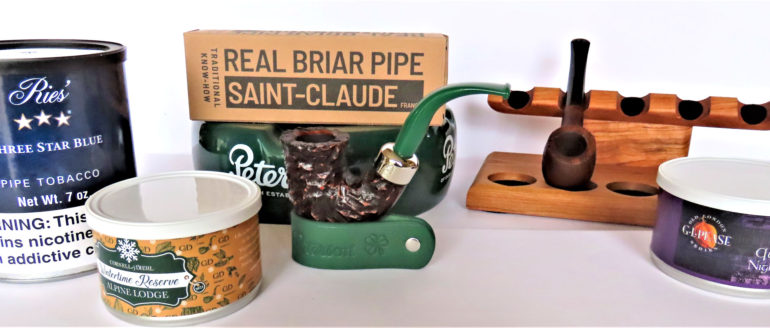
“Tis the times’ plague, when madmen lead the blind.”—William Shakespeare
“How now?”
“Even so quickly may one catch the plague?” — William Shakespeare
There we were, thinking the plague seemed to be fading. And then, omicron, the little Greek “o” with a big “Omen” arrived and set the world ablaze with virus.
Sometime, in the days before the current darkness, at a pipe show in Raleigh, Va., PipesMagazine’s Radio Show host Brian Levine, the pipes and tobacco veteran, told me an old tale: a British doctor was perplexed by the plague of typhoid deaths. He happened by a water source in which the citizenry pumped their daily water from a public well supplied by an underground aquifer.
He studied the source and then advised town authorities the way to be rid of the scourge: “take the handle off the pump.”
That was in the late 19th century, and it was later discovered that typhoid, Salmonella enterica, was the culprit. Historically, the bacteria were said to have caused the death of Pericles, Greek Athenian leader of sometime in the 460s BC.
Oh, the horror!
All, right, enough of this sorrowful start. Onward, shall we?
I have been thinking of an old friend who smoked nothing but Bugler tobacco. That tobacco, manufactured in 1932, was primarily for roll-your-own cigarette smokers.
My friend, a really fine writer who once authored a book published by Random House, smoked Bugler because it was a cheap blend of Turkish and burley or Virginia or both. It was a grand-slam mixture of tobacco and is still produced for cigarette smokers.
I tried a bowl given to me by my writer buddy, who later became a public relations spokesman for a prominent Washington politician.
That one bowlful taught me a valuable lesson: watch what you ask for in pipe tobacco. To say that I had an out of body, otherworldly experience, envisioning an alternative existence—pretty well sums up my one and only foray into Bugler tobacco!
I never sampled that sort again and have remained cautious about burleys and Virginia combos ever since.
One more note about strong tobaccos. Now, I realize many of you are stout enough, experienced enough—to smoke old shoe leather, but take heed as I share another tale.
Once upon a time, in a now-departed brick and mortar pipes and tobaccos store a young pipe smoker wanted to try one of Samuel Gawith’s strongest tobaccos.
My tobacco merchant friend recommended Samuel Gawith’s 1792 Flake, a Virginia based of Tanzanian leaf laced with strong Tonquin bean but recommended caution. The Newbie cast restraint to the winds, stated with youthful confidence he could handle it, opened the tin, filled his pipe, lit it up and took a deep draw: Newbie hit the deck after that big puff.
Why go into all this? Well, the Pundit has been contemplating a great deal about pipes and tobacco in our time of plague. They comfort us, and if we follow our instincts about smoking a pipe, follow our feelings, follow our best thoughts, we will find enjoyment at the end of these dark days.
I moved on from that early Bugler experience to find wonderful tobacco blends, from aromatics to, yes, burley and Virginias—but touched up with Perique, and Orientals.
So this bit of advice for all you new pipe smokers out there. Don’t give up. You will find that right blend.
However, if a pipe reviewer such as Jiminks on tobaccoreviews.com says your choice is strong, beware. Jiminks is an exceptionally reliable source, a veteran pipe smoker, who knows blends, strengths, nicotine power and more.
Another piece of advice from an old deep South barbecue chef whose famous restaurant I once frequented: slow and low is how you cook the best “Q.”
Of course, you must also have the right “Q” sauce, which I won’t reveal here on pain of severe punishment from my barbecue chef pal.
But slow and low is how I prefer to puff. No matter whether or not it’s an aro or one of those magical mixtures by true masters of tobacco blending.
And here is another old-world tip from the Pundit: Yes, I like pipe lighters, and I have drawerfuls of ‘em; some famous brand names, some collectibles, some lesser knowns.
But the best and safest method by which to light your bowl I have found is with an old-fashioned wooden kitchen match. Say, the “Diamond” brand. The stick is, roughly speaking, two and three-eighths inches long and the flame is soft and round enough so as to not scorch that beautiful birdseye rim on your precious pipes.
By the way, for those of you of insatiable curiosity on all things tobacco and pipe-related, Chuck Stanion has an excellent essay on pipe rims in his August 2020 Pipe Line column on SmokingPipes.Com
Now, with cobs, or, say, an old basket pipe, I haul out flame throwers.
This month, the shortest of the year, we honor a rather famous World War II journalist, author, historian and pipe smoker: William L. Shirer.
Shirer, who wrote the top-selling The Rise and Fall of the Third Reich: A History of Nazi Germany in 1960, was born Feb. 23, 1904, in Chicago, Ill., and died Dec. 28, 1993, in Boston. He was 89.
Shirer, who was once characterized as something of a “pipe-smoking” professorial type, was a prolific writer. He also combined his journalistic skills with radio broadcasting back to the U.S. with CBS while in Berlin during the opening year of World War II.
His two books that put the Pundit on the road to delving into World War II history were Berlin Diary, published in 1941, and his work on the Third Reich.
In particular the Pundit likes this Shirer quote:
History must speak for itself. A historian is content if he has been able to shed more light.
And, before I let you go not so gently into that good and dark February night, our time together would not be complete if we did not consider our Founding Fathers. With hallowed President’s Day soon upon us, it is important not to forget this is also the month we honor U.S. presidents on President’s Day.
The holiday was begun initially to honor President George Washington on his birthday, Feb. 22. But all that changed due to calendar goofs and then a move to honor all presidents.
This year, President’s Day falls on Feb. 21, and Washington’s birthday is Feb. 22.
Confused? So is the Pundit. Just know that many of our Founding Fathers were tobacco planters, and most of them enjoyed a bowl or two during their busy founding days.
And in modern times, we have accounts of Presidential pipe smoker Gerald R. Ford (1913-2006), 38th President (1974–77), who was rarely seen without his pipe.

Photo by Fred Brown

















